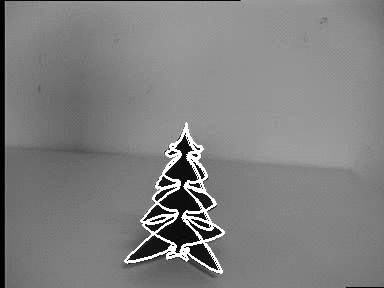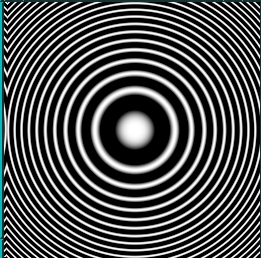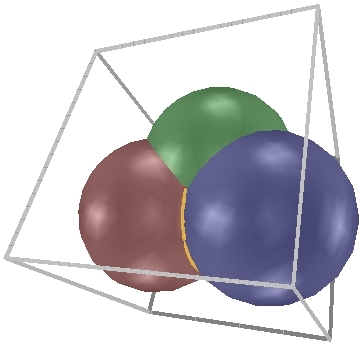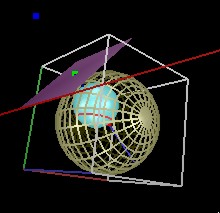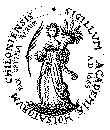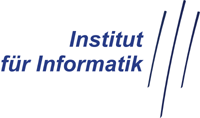| 2004 |
Pose Estimation of Free-form Objects
Rosenhahn B., Sommer G., Klette R.
Technical Report 0401, Christian-Albrechts-Universität zu Kiel, Institut für Informatik und Praktische Mathemati
k, März 2004
|
PDF, Bibtex |
| 2003 |
The hypersphere neuron
Banarer V., Perwass C., Sommer G.
In Proc. 11th European Symposium on Artificial Neural Networks, ESANN 2003, Bruges, pp. 469-474. d-side pu
blications, Evere, Belgium, 2003
|
PDF, Bibtex |
| 2003 |
Pose estimation of free-form surface models
Rosenhahn B., Perwass C., Sommer G.
In 25. Symposium für Mustererkennung, DAGM 2003, Magdeburg, Vol. 2781 of LNCS, pp. 574-581, Springer-Verla
g, Berlin, 2003.
|
PDF, Bibtex |
| 2003 |
Implementation of a Clifford algebra co-processor design on a field programmable gate array
Perwass C., Gebken C., Sommer G. <
br>
In R. Ablamowicz, Editor, 6th International Conference on Clifford Algebras, and Applications, , Cookevil
le, TN, CLIFFORD ALGEBRAS: Application to Mathematics, Physics, and Engineering, pp. 561-575, Birkhäuser, Boston, Progress in Mathe
matical Physics, 2003
|
PDF, Bibtex |
| 2003 |
Pose Estimation Revisited
Rosenhahn B.
Dissertation, Institut für Informatik und Praktische Mathematik, Christian-Albrechts-Universität zu Kiel, 2003.
|
PDF, Bibtex, Abtract |
| 2002 |
Low-Level Image Processing with the Structure Multivector
Felsberg M.
Dissertation, Institut für Informatik und Praktische Mathematik, Christian-Albrechts-Universität zu Kiel, 2002. -
|
PDF, PS, Bibtex |
| 2002 |
Pose Estimation of 3D Free-form Contours
Rosenhahn B., Perwass C., Sommer G.
Technical Report 0207, Christian-Albrechts-Universität zu Kiel, Institut für Informatik und Praktische
Mathematik, August 2002
|
PDF, Bibtex |
| 2002 |
Pose estimation of 3D free-form contours in conformal geometry
Rosenhahn B., Perwass C., Sommer G.
In D. Kenwright, editor, Proceedings of Image and Vision Computing, IVCNZ, Auckland, NZ, pp. 29-34. 2002 -
|
PDF, Bibtex |
| 2002 |
Adaptive pose estimation for different corresponding entities
Rosenhahn B., Sommer G.
In L. Van Gool, editor, Pattern Recognition, 24. Symposium für Mustererkennung, Zürich, September 2002, Vo
l. 2449 of LNCS, pp. 265-273. Springer-Verlag, Berlin Heidelberg, 2002
|
PDF, Bibtex |
| 2002 |
Monocular pose estimation of kinematic chains
Rosenhahn B., Granert O., Sommer G.
In L. Dorst, C. Doran and J. Lasenby, editors, Applications of Geometric Algebra in Computer Science and Engin
eering, pp. 373-375. Proc. AGACSE 2001, Cambridge, UK, Birkhäuser Boston, 2002
|
PDF, PS, Bibtex |
| 2002 |
A geometric approach for the analysis and computation of the intrinsic camera parameters
Bayro-Corrochano E., Rosenhahn B.
Pattern Recognition, 35:169-186, 2002
|
PDF, Bibtex |
| 2001 |
Geometric Computing with Clifford Algebras
Sommer G.
Springer-Verlag, Heidelberg, 2001
|
PDF, Bibtex |
| 2001 |
Pose estimation using geometric constraints
Sommer G., Rosenhahn B., Zhang Y.
In R. Klette, T. Huang and G. GimelŽfarb, editors, Multi-image analysis, Vol. 2032 of LNCS, pp. 153-170. P
roc. Dagstuhl Workshop on Theoretical Foundations of Computer Vision, Springer-Verlag, Berlin, 2001
|
PDF, Bibtex |
| 2001 |
Introduction to neural computation in Clifford Algebra
Buchholz S., Sommer G.
In G. Sommer, editor, Geometric Computing with Clifford Algebra, pp. 291-314. Springer-Verlag, Heidelberg,
2001
|
PDF, PS, Bibtex |
| 2001 |
Local hypercomplex signal representation and applications
Bülow T., Sommer G.
In G. Sommer, editor, Geometric Computing with Clifford Algebra, pp. 255-289. Springer-Verlag, Heidelberg,
2001
|
PDF, PS, Bibtex |
| 2001 |
Commutative hypercomplex Fourier transforms of multidimensional signals
Felsberg M., Bülow T., Sommer G. <
br>
In G. Sommer, editor, Geometric Computing with Clifford Algebra, pp. 209-229. Springer-Verlag, Heidelberg,
2001
|
PDF, PS, Bibtex |
| 2001 |
The monogenic signal
Felsberg M., Sommer G.
IEEE Transactions on Signal Processing, 49(12):3136-3144, December 2001
|
PDF, PS, Bibtex |
| 2001 |
Coordinate-free projective geometry for computer vision
Li H., Sommer G.
In G. Sommer, editor, Geometric Computing with Clifford Algebra, pp. 415-454. Springer-Verlag, Heidelberg,
2001
|
PDF, PS, Bibtex |
| 2001 |
3D-reconstruction from vanishing points
Perwass C., Lasenby J.
In G. Sommer, editor, Geometric Computing with Clifford Algebra, pp. 371-392. Springer-Verlag, Heidelberg,
2001
|
PDF, PS, Bibtex |
| 2001 |
The motor extended Kalman filter for dynamic rigid motion estimation from line observations
Zhang Y., Sommer G., Bayro-Corrochano E.<
/span>
In G. Sommer, editor, Geometric Computing with Clifford Algebra, pp. 501-530. Springer-Verlag, Heidelberg,
2001
|
PDF, PS, Bibtex |
| 2001 |
Analysis and computation of the intrinsic camera parameters
Bayro-Corrochano E., Rosenhahn B.
In G. Sommer, editor, Geometric Computing with Clifford Algebra, pp. 393-414. Springer-Verlag, Heidelberg,
2001
|
PDF, PS, Bibtex |
| 2000 |
Applications of Geometric Algebra in Computer Vision
Perwass C.
Dissertation, Cambridge University, 2000.
|
PDF, Bibtex |
| 2000 |
Extended Kalman filter design for motion estimation by point and line observations
Zhang Y., Rosenhahn B., Sommer G.
In G. Sommer and Y. Zeevi, editors, 2nd International Workshop on Algebraic Frames for the Perception-Action C
ycle, AFPAC 2000, Kiel, Vol. 1888 of LNCS, pp. 339-348. Springer-Verlag, 2000
|
PDF, Bibtex |
| 2000 |
Motor algebra for 3D kinematics: The case of hand-eye calibration
Bayro-Corrochano E., Daniilidis K., Somme
r G.
Journal of Mathematical Imaging and Vision, 13:79-100, 2000
|
PDF, Bibtex |
| 1999 |
The global algebraic frame of the perception-action cycle
Sommer G.
In B. Jähne, H. Haussecker and P. Geissler, editors, Handbook of Computer Vision and Applications, pp. 221
-264. Academic Press, San Diego, 1999
|
PDF, Bibtex |
| 1999 |
Hypercomplex Spectral Signal Representations for Image Processing and Analysis
Bülow T.
Dissertation, Institut für Informatik und Praktische Mathematik, Christian-Albrechts-Universität zu Kiel, 1999. -
|
PS, Bibtex |
| 1999 |
Hand-eye calibration using dual quaternions
Daniilidis K.
Int. Journal Robotics Research, 18:286-298, 1999
|
PDF, Bibtex |
| 1997 |
A unified language for computer vision and robotics
Bayro-Corrochano E., Lasenby J.
In G. Sommer and J.J. Koenderink, editors, Algebraic Frames for the Perception-Action Cycle, Vol. 1315 of
Lecture Notes in Computer Science, pp. 219-234. Int. Workshop AFPACŽ97, Kiel, Springer-Verlag, Heidelberg, 1997
|
PDF, PS, Bibtex |
| 1997 |
What can Grassmann, Hamilton and Clifford tell us about computer vision and robotics
Bayro-Corrochano E., Lasenby J., Sommer G
.
In E. Paulus and F.M. Wahl, editors, Mustererkennung 1997, Tagungsband 19. DAGM-Symposium, pp. 164-171. DA
GMŽ97, Springer-Verlag, 1997
|
PDF, PS, Bibtex |
| 1995 |
Object modelling and motion analysis using Clifford algebra
Bayro-Corrochano E., Lasenby J.
In R. Mohr and W. Chengke, editors, Proc. Europe-China Workshop on Geometrical
Modelling and Invariants for Computer Vision, pp. 143-149. 1995
|
PDF, PS, Bibtex |
